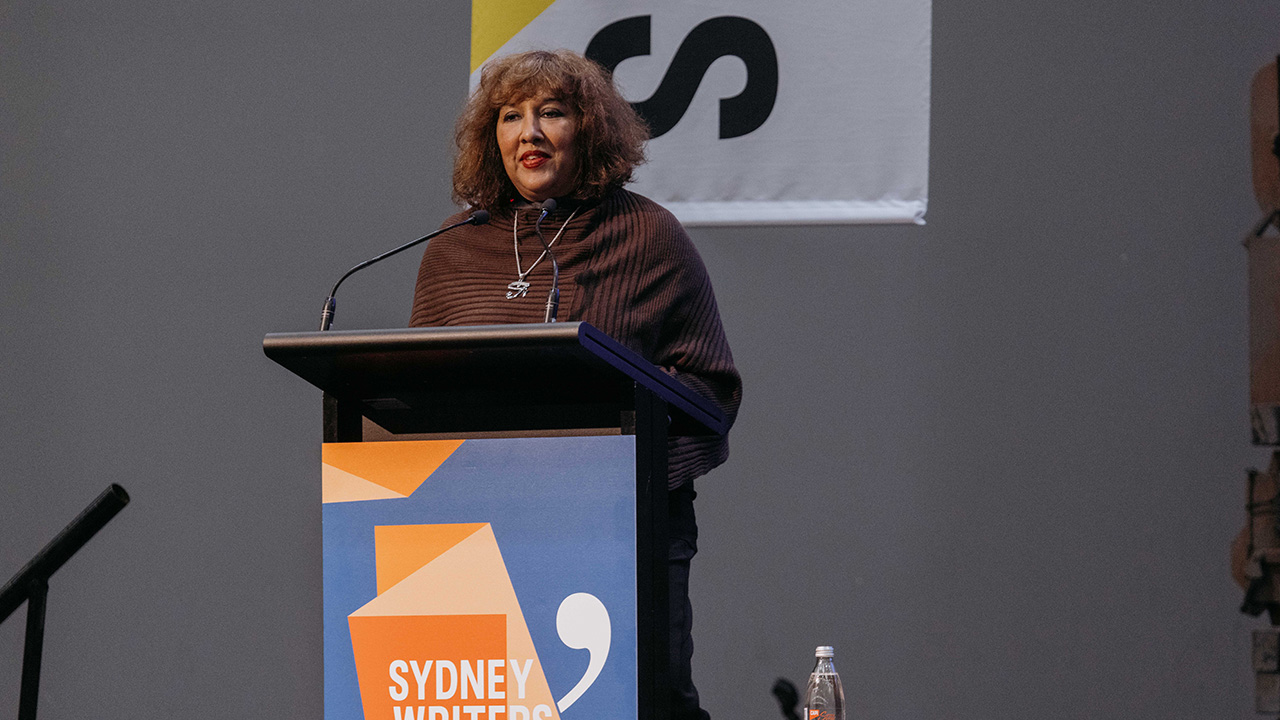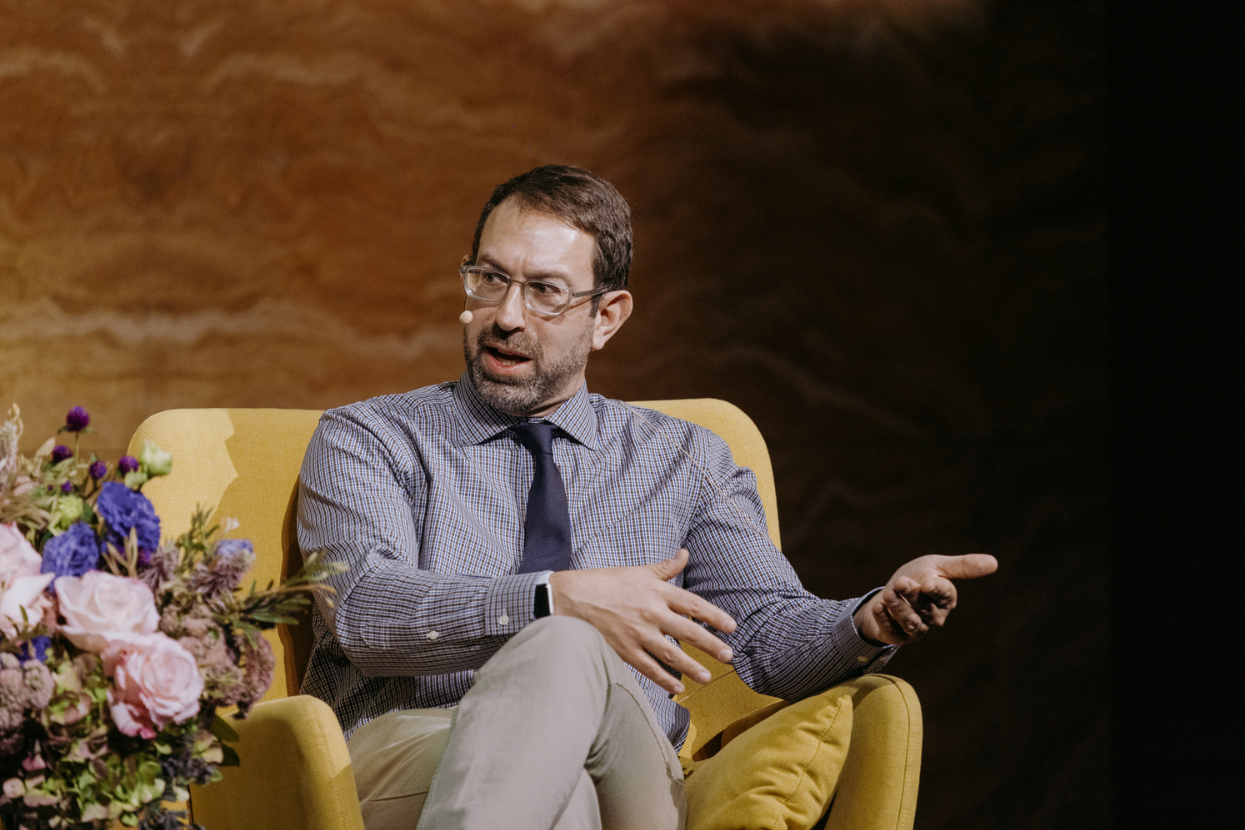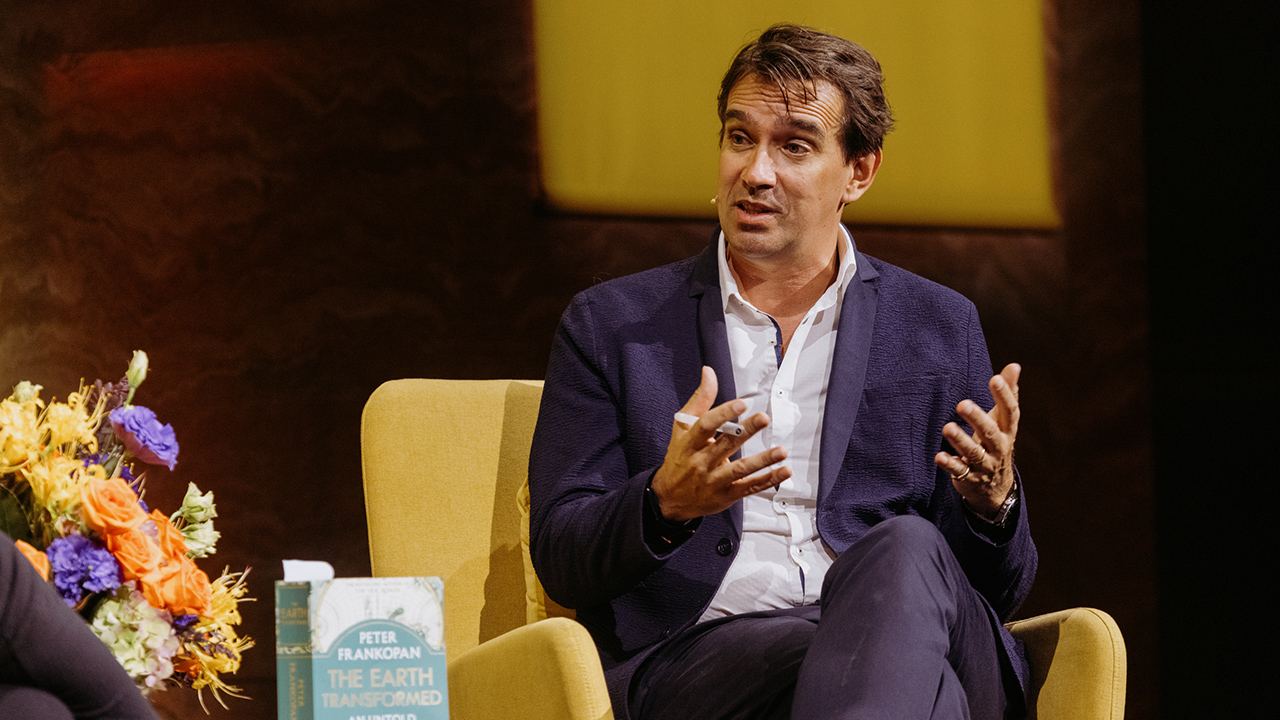Raina MacIntyre on Past, Present and Future Pandemics

We are walking a tightrope when we are trying to reap the benefits of technology without destroying ourselves in the process.
Hear from world-leading epidemiologist and Dark Winter author Raina MacIntyre as she examined pandemics through the lens of history, what lessons we have learned, and how we might navigate the new frontiers of biosecurity. She provided a glimpse into quantum advances in genetic engineering and synthetic biology, and considered calls for a cross-disciplinary, global approach to safeguard our future.
This event was presented by the Sydney Writers' Festival and supported by UNSW Sydney.
Transcript
UNSW Centre for Ideas: Welcome to the UNSW Centre for Ideas podcast – a place to hear ideas from the world's leading thinkers and UNSW Sydney's brightest minds. The talk you are about to hear, Raina MacIntyre on Past, Present and Future Pandemics features UNSW Sydney epidemiologist Professor Raina MacIntyre, and was recorded live at the 2023 Sydney Writers’ Festival.
Raina MacIntyre: Thank you so much for coming to this session. I'd like to acknowledge the traditional owners of the land, the Gadigal people of the Eora Nation, and pay my respects to elders past and present, and to any Aboriginal or Torres Strait Islander people here today.
So I'm going to tell you a bit about my book, Dark Winter, and the reasons why I wrote it. In 2020, when the pandemic was brand new, Elspeth Menzies over there contacted me and said, "Would you like to write a book?". And of course, I'm an academic, so research is what I do full time. We were very, very busy doing a series of different research studies on the transmission of SARS-CoV-2 and on masks and other things related to the pandemic. So I said, "Wait, please check back with me next year," which she did.
I'm glad she did because it gave me an opportunity then to summarise in a book, a nonfiction book, my knowledge and experience of a career of more than 30 years now in infectious diseases and some of the concerns that have occurred to me during that journey about biological threats, and why people need to know about it.
We know about climate change, right? We all know about climate change. Can you raise your hand if you're having trouble understanding me with the mask? Okay. Is that better? Okay, I'll take it off. I did use an antiviral spray just before I came on, which is like a second line of defence. So I'm happy to talk for 30 minutes without a mask. But COVID is on the up again, and it's a new strain that's not that well covered by the vaccines that are available. So it's worth protecting yourself.
So we all know about climate change, right? Because we've seen the effects, we've felt the effects with breathing in the smoke during the bushfires, we've seen the floods, we've had people affected around us. We know about cybersecurity, right? We know about cyber threats. Because many of us have been affected by data breaches. We've received a letter from a communications company or health insurance company saying, "Oops, sorry, your private information has been compromised."
Well, biotechnology also poses a great threat to humankind. But there's almost no awareness of it. We hear a lot about the good things we can do with biotechnology, but very little about the harm. So that's why one of the things I wanted to convey in this book is the sense of urgency about the threats that we face.
Interestingly, history repeats itself. We all know that. But what makes it different today with history repeating itself is that the kind of technology that's available today actually makes biological research an existential threat to the survival of the human species. So I talk in the book about unnatural and natural epidemics and I give a range of examples that are real examples. So they can't be labelled a conspiracy theory, they are facts. And I talk again and again about natural or unnatural epidemics. When you think about terrorism, as you know it, even a five-year-old child can tell you if a building collapses due to a bomb or an earthquake, right? It's very easy to differentiate a physical attack, a physical event that's natural or unnatural. Now, that's just not the case with biological events. With an epidemic, it is actually really difficult, even for the most seasoned experts, to differentiate a natural and an unnatural epidemic. So understanding the past, the present, and the future of pandemic spot threats and biosecurity is important.
Did you hear that? That was silence. It's silence around unnatural epidemics, which has been a recurring theme throughout history, which is what I outline in my book by giving example after example of unnatural outbreaks, either lab leaks or deliberate attacks that were covered up for usually a decade or longer.
So I'm going to tell you a true story about an unnatural epidemic that occurred in a city in the United States. One September, people started getting sick with vomiting and diarrhoea, gastroenteritis and more and more people started getting sick until eventually there were about 700 people sick. It was salmonella, which is a common cause of food poisoning. And at the time, the public health authorities hadn't ever seen an epidemic of salmonella that was that big, so they called in the US CDC [United States Centre for Disease Control] to help investigate. And the one thing they found out was that everyone who got sick had eaten out at a restaurant. But it wasn't just one restaurant, it was at least 10 different restaurants.
So okay, you might think maybe it was the eggs or some other ingredient, the water, the milk. They looked into all of that, and there was absolutely no common ingredient between the restaurants where people got sick. The only thing they found in common was that all of the restaurants had a salad bar, and some of those restaurants also had private dining rooms where the same food was served, but only people who ate at the public salad bar got sick. So, you've probably worked it out yourself now, thinking about those facts but the public health investigators said this is just an outbreak due to unsanitary food handling, even though the sanitation was perfectly okay in all the restaurants they inspected.
Then there was a politician, a guy called Jim Weaver, who said, "You know, I think the local cult did this, they poisoned those people", and he was shouted down by the public health authorities and ridiculed. He then went to the media with his concerns, and he was ridiculed even more. The CDC and the State Health Authority shut down the restaurants. The outbreak finished, end of story, except six months later, the cult leader, Rajneesh, Shree Bhagwan Rajneesh, the ‘Orange People’, if you might remember, he confessed and said, "We did it". But guess what, nobody believed him. So how can you ever identify an unnatural epidemic if even a confession isn't believed? So that's what we're up against. That's the sort of cultural landscape we're up against in the denial of unnatural epidemics.
Then, a full 12 months later, the FBI was raiding their ranch in an immigration raid, so completely unrelated, and quite by accident, they stumbled upon a laboratory on the Rajneesh ranch, and it contained the exact outbreak strain of salmonella as well as other more dangerous pathogens such as typhoid. And that was the largest documented biological attack in the US. It was covered up and silenced for 12 years, nobody was told anything about it. There's a great documentary on Netflix called, Wild, Wild Country about this cult and the things they did. It's really quite a riveting series. Some of the things they used to do was they target individual enemies with poisoned chocolates or poisoned drinks, right. So people might have died or have been harmed by these individual targeted attacks, but no one ever knew about it. So if someone's spouse or loved one died because they were poisoned by the Rajneeshees, they wouldn't have ever known about it, there was no prospect of getting justice. So you see, it's important to know, isn't it? The public deserves to know.
The reason they did it was they were in conflict with the council on the use of their land. And they wanted to win the local elections. So they planned to poison the town water supply, leading up to the election, so that they could just be the only people voting, win the election, and control the land. And they had a Plan A which didn't work out, so the Plan B was poisoning the water supply. So that's just one example. But when you look back through history, particularly during the Cold War, but I'm sure even now, the US, the Soviet Union, and the UK did a lot of biological warfare development and they experimented on their own populations during the Cold War.
I opened the book talking about Operation Seaspray, which was a US military biological weapons testing exercise where they sprayed bacteria for six days over San Francisco. And you could detect the bacteria as far away as Berkeley and other cities a long way away. A whole bunch of people got sick. They thought these bacteria that were sprayed were harmless, but a whole bunch of people actually got sick, and one person died. But it was only 27 years later, when a journalist uncovered something about it, that the son of the men who died pursued it, and then the US government disclosed some biological weapons experiments. The US military and the EU in the UK as well, they used to drop light bulbs into the subway system filled with trillions of bacteria that were a proxy for anthrax. It wasn't anthrax, but it was a bacteria that was thought to be harmless but wasn't. But no one knew about it. So if you got sick while you were commuting, you wouldn't have been able to put two and two together.
The Soviet Union, we know a lot about their biological weapons testing program because the Deputy Director defected to the US and wrote a book about it. They had a little island in the Aral Sea called Vozrozhdeniya where they experimented on all kinds of pathogens, including smallpox. And in one instance, they exploded a smallpox bomb on this island, and someone on a passing ship got infected 15 kilometres away. So that's how far smallpox can be aerosolised in a weaponised attack.
In 1977, there was a Russian, so-called Russian flu pandemic, which for 30 years, scientists insisted was natural, even though it had a particular genetic signature that screamed unnatural. The theory of a lab leak was shouted down for 30 years until finally, long after the Cold War was over, it was accepted that it was actually a vaccine development experiment gone wrong. They were making live influenza vaccines in China and Russia at the time. And the virus itself had a signature of vaccine-type viruses so somehow that got out and caused a pandemic. The usual suspects for blaming unnatural epidemics are animals, wet markets, or the melting permafrost in the Siberian tundra. You hear that talked about all the time, articles saying, "Oh, smallpox is coming back because the cadavers are defrosting in the Siberian permafrost". True. Look it up. Yeah, there are articles on it.
Although the Soviets and the US and everyone else were experimenting on creating chimeric viruses, we know from Alibek, the defector who wrote a book about the Soviet program, they were trying to put genes from other viruses into smallpox to make it more deadly, more contagious, etc. In fact, that explosion, the American scientists called it the Aralsk-7 strain. But the Soviets always denied that it was some special strain, but it had a very, very high death rate in the outbreak that occurred. But what's changed since then is the technology, right? If people were trying to engineer super mutant viruses in the 1970s, 100% for sure, they're doing it now. We know they're doing it because there are published papers on it in the last 30 years.
Do you remember the movie Gattaca in 1997? So at the time, if you saw it like I did back then, it really looked like science fiction, right? It didn't feel like that could ever be real, that you could have a whole society of engineered human beings and an underclass of naturally born human beings. But that's exactly what's possible right now. In the UK and Sweden, they started research on the engineering of human germline in embryos in 2016.
And then, in 2018, a Chinese scientist caused an international uproar by actually not only engineering two embryos but bringing those babies to term. And so they are living, living human beings now who are engineered. Interestingly, it caused a huge uproar. Everyone said it was unethical in all countries. Everyone was sort of outraged about it. But very soon afterwards, new regulations came in and up by through WHO [World Health Organisation], CDC, everyone jumped on the bandwagon with new regulations on human germline editing.
So, you know, one of my colleagues who's in the Army Reservist here and a biological weapons expert thinks that the new arms race is engineering of human beings. It's in the public domain that definitely in the US and the UK, there are ongoing research efforts to engineer super soldiers. So, human beings who are more powerful, stronger, fitter, resistant to pain, able to go without sleep, etc. I don't know what the exact manifestations are, but super soldiers. You can Google it, ‘super soldiers’. There's an article in The Conversation about it.
So, on the one hand, we now have the technology to engineer human beings. Absolutely. It's a matter of time before parents will be choosing genetic characteristics for their kids. And there are obviously desirable things there because you can eliminate genetic diseases, but there's a whole lot of ethical issues as well. But at the same time, if you think about it from a military perspective, a hostile nation can introduce something into the food supply that adversely affects a whole population on a genomic level and then hits them with a biological weapon.
And the technology for the development of biological weapons has also gone ahead in leaps and bounds. We call this dual-use research of concern. And you see it in any area like robotics, drones, artificial intelligence, where it's research that is meant to benefit humanity but can also harm humanity. And some of these are existential threats, and there's been a convergence of a lot of these technologies, including cyber technology, where the dark web allows a lot of people to purchase and procure genetic code and nefarious substances under the radar of law enforcement.
And it really is a tightrope that we're walking where we have to try to reap the benefits of the technology without destroying ourselves in the process. You know, there were experiments in the mid-2000s. After SARS-1 in 2003, scientists were fascinated with SARS, and they were experimenting from then on, on creating a version two of SARS. There are published papers on it. This isn't conspiracy theory. It's a fact. And there are published papers in 2017. Some Canadian scientists created in a lab from scratch a pox virus that was very, very closely related to smallpox and they themselves said it is no longer possible to eradicate any virus because they can be made in the lab.
So that is called synthetic biology where you can make a virus in a lab. You don't need to break into the supposed two places in the world where the smallpox virus is held. One is the US CDC, and the other is a Vector Lab in Russia. And it's probably impossible to break in there and steal it, which is what intelligence people were worried about. But nobody needs to do that anymore because you can make it.
What if smallpox were to re-emerge? About 20 years ago, some Australian scientists actually, quite by accident, again did some dual-use research with a very unexpected side effect. They were trying to address the mouse plague. You know, you've seen those pictures in country towns with mice crawling all over people running through the houses. So they're trying to address this mouse plague by engineering the eggs of the mice to be sterile, to sterilise the mice. But quite by accident, when they did this genetic engineering of the mice, they ended up resistant to the vaccine for smallpox because they were using our orthopox virus, which is a related virus, and the smallpox vaccine protects against pretty much all of the related viruses. So it was resistant to the vaccine, and this virus, in nature, that is pretty mild in mice, doesn't kill them. It killed all the mice. So double whammy, universally fatal and resistant to the smallpox vaccine. So you could theoretically do that same engineering to the smallpox virus and create a virus that the vaccines don't work against. And that is 100% fatal. Natural smallpox is 30% fatal. And, you know, we use vaccines to eradicate it. The vaccines are highly effective, but it will be a completely different game if we didn't have vaccines.
The other type of gain-of-function research is where you take a virus that exists in nature and confer on properties it doesn't normally have, like making it more lethal, more contagious, or resistant to drugs and vaccines. That field has been active since around 2012 when two scientists wanted to publish the methods, they developed for engineering avian influenza viruses to be transmissible in mammals, in other words, humans. Avian flu viruses, often referred to as ‘bird flu’, do not typically spread between humans. Humans can get infected with them if they handle a dead or sick bird, but generally, even if a person gets infected, they’re not going to transmit to others because birds have different receptors in their respiratory tract compared to humans.
For avian flu viruses to cause the next pandemic, they would need to switch their receptors to have an affinity for the human respiratory tract. And that's exactly what these scientists did. They switched the receptor affinity to make avian flu viruses transmissible in humans. There was a brief moratorium on that kind of research, but the scientists lobbied hard, saying that the future of humanity depended on them on being able to do this research and make viruses more dangerous.
So there are two ways this kind of research can result in harm, basically error and terror. Error, terror, warfare, and biological warfare and terrorism have been documented throughout recorded human history. The Persians, Romans, and Greeks – they all used to use it. It was used extensively in World War II, during the Cold War, in Rhodesia, South Africa, and then we had more recent attacks in the US after 9/11. There was an anthrax attack which I write about in the book. And lab leaks – they are really, really common.
You can just go on the website of the American Biosafety Association. They catalogue all the lab leaks from around the world, and you can spend a weekend reading about the interesting lab leaks and who's died and who's gotten ill from these lab leaks. So they are really common, even in top-notch labs. In one of the interesting outbreaks that I talk about is the massive leak of anthrax from one of the Soviet bioweapons plants in a place called Sverdlovsk in the Soviet Union. A technician forgot to replace the valve on the air filter, right, forgot to replace the filter on the external air filter, and that resulted in weaponised anthrax being pumped into the town all night long until the next technician on the next shift realised the mistake and put the filter in.
At the time of the incident, it was public knowledge that people had developed inhalational anthrax. So in natural anthrax, usually it is cutaneous, it presents with a lesion on the skin. Very, very rare to get anthrax in the lung. Naturally, if you see even one person with inhalational anthrax, you've got to think this is an attack.
So we had, you know, dozens of cases known about at the time. The Soviets said it was natural. It was the market, the wet market, let's go and kill some animals. They did a big theatrical display of killing animals and even killing the stray dogs in the market. And guess what? The Americans agreed with them, not the intelligence agencies. Intelligence agencies had satellites, intelligence, and other intelligence that suggested that Sverdlovsk had come under military control at that time, and that there had been a major incident.
But the medical and health and science people will say, "No, no, it's natural". They even went to Russia and obviously, they were subject to whatever the Russians would have told them. But again, it was only after the fall of the Soviet Union, much later, that Boris Yeltsin confessed that it had been a lab leak. And then the same American scientists went out there again and wrote papers. And you know, all that history is kind of forgotten. But everybody on the medical science side denied that it was unnatural when it was patently obvious, it was unnatural.
Interestingly, with the COVID, the origins of COVID, if you're following the investigation going on in the US in the House, at the moment, there's been a lot of stuff released under Freedom of Information, quite damning stuff of cover-ups of intelligence and information. There certainly is enough, you know, a lab leak is certainly a credible explanation could have arisen in nature, but could equally have arisen from a lab leak. And in fact, there is some leaked intelligence data showing a drop in traffic, you know, mobile phone signals and other things that indicated something happened around that lab in Wuhan around October 2019.
So in the US, when the anthrax attacks occurred shortly after 9/11, you may remember there were letters sent to various media outlets actually, but also to certain politicians, Senator Tom Dashiell and Patrick Leahy, and several people died. And it kind of shut down the US Postal Service. It had quite a catastrophic impact in terms of the societal impact that it had. And the strain of anthrax, lo and behold, was an American strain. It was the Ames strain which had come from a cow in Texas and was being used at the USAMRIID [United States Army Medical Research Institute of Infectious Diseases], the US military lab that was doing biological research. It had come from that lab. So then they began investigating for an insider, and that's also something I talked about in the book, which is insider threat, just like in the corporate world, insider threat is just as real a threat in biological science. Same motives, plus fame and glory and research funding and patents on vaccines, etc.
But the interesting thing was the medical research community would not accept that the final suspect that the FBI honed in on could have done it. And there's another American scientist who actually did some prison time after having lost some samples of plague. And again, the whole medical research community really stood behind that scientist and kind of condemned the FBI. And the argument kind of goes, they are scientists, they're special, they should be allowed to do things and they don't have, you know, they don't have to meet the same standards as other people. So, it's very interesting. There's a real dissociation between the view of law enforcement and the view of the scientific community when it comes to misconduct in science.
So then I talk about the fact that information warfare is a really important factor. It's a factor in everything, right? You'll remember lots of examples in our lifetimes, but in terms of medicine and medical research, it's huge. Tobacco science, for example, it took 100 years for the medical establishment to uniformly accept that smoking is bad for you. And that's because the tobacco industry threw all its power and wealth behind a concerted campaign of information warfare that included supporting doctors and scientists to do counter-narrative research. So every time a research study came up showing cigarettes are bad for you, another study would be published that showed they're not so bad after all. And, you know, major medical journals used to advertise tobacco in their pages.
More recently than that, two Australians who won the Nobel Prize for Medicine and Physiology, Professors Barry Marshall and Robin Warren from Perth, they won the Nobel Prize for proving that stomach ulcers are caused by a bacterium. And at the time, the prevailing theory was that stomach ulcers were caused by stress and one of the first drugs to break the billion-dollar sales ceiling were these antacid drugs called H2 blockers, which meant that if you had a stomach ulcer, you have to be on these drugs for life.
That's big business. Whereas if it was an infection, just one course of antibiotics is all you need to fix your stomach ulcer, right? There was also a whole industry of psychiatrists and surgeons treating stomach ulcers. So there was a huge pushback against Marshall and Warren's findings, including in Australia. The Australian gastroenterological society wouldn't let them publish or present their research. In fact, you know, early on, I heard Barry Marshall speaking at conferences, and he used to put up all the rejection letters and the rude letters he'd get from all over the place about his research. So that was another more recent example of information warfare. So every time there were papers supporting what they had found out, there were counter-narrative papers published saying it was due to stress.
So getting back to biological technology, the problem is just like with cybersecurity, like in the cyber world, we know that the criminals are way ahead of the police, right? They have all the latest technology, they're doing all the latest things, and the police and intelligence agencies are just playing catch-up, right? We're probably 10 years behind in biosecurity compared to cybersecurity. But it's also a catch-up game. And I have spoken to a lot of police and intelligence people, spoken at their conferences, and there's very, very low awareness of the kind of landscape that we're dealing with now.
So what are the solutions? And how are we going to deal with this threat? I don't think the solution is with scientists because scientists have a vested interest in having the freedom to do what they want to do, which is not a bad thing in itself because obviously, science has a lot of gains for humanity as well. Maybe the solution will come from law enforcement and intelligence. But I don't think so because when you look at what happened in the US, the whole question of COVID origins was hugely politicised and the intelligence agencies just fell in step. There's a discrepancy, so most recently, two of the agencies said yes, two said no, but they were clearly influenced politically as well.
In the end, I think it's the people – power of the people. You know, it's like climate change. It's awareness in human beings and the community that will drive change if there is to be change. And that means that knowledge needs to be available to everybody, people need to understand what's at stake.
So I've recently been asked to join an organisation in the US called Biosafety Now, and they're actually connecting with people in the community who are concerned about certain labs being built in their communities without adequate transparency or information for the community. I mean, the community is the ultimate stakeholder, whether it's a cure for cancer or a pandemic that's going to kill your loved ones. The community is the ultimate stakeholder. But this kind of stuff goes on without any consent, without any information provided to the communities. I think that's got to change. And that's probably why I wrote the book, to try and convey my concerns and my knowledge in a digestible format for anyone to pick up and absorb.
Thank you so much for coming.
UNSW Centre for Ideas: Thanks for listening. This event was presented by the UNSW Centre for Ideas and Sydney Writers’ Festival as a part of the Curiosity Lecture Series. For more information, visit centreforideas.com and don’t forget to subscribe wherever you get your podcasts.
-
1/3
Raina MacIntyre on stage at Carriageworks
-
2/3
Raina MacIntyre
-
3/3
Raina MacIntyre on stage

Raina MacIntyre
Professor Raina MacIntyre is a dual-specialist physician with a masters and PhD in epidemiology, training in outbreak investigation and over 450 scientific publications. She is a leader in pandemics, bioterrorism, vaccines and facemasks, on expert committees for the WHO and other bodies. She has won many awards including the Sir Henry Wellcome Medal and Prize from the Association of Military Surgeons of the United States and the Eureka Prize for Leadership in Science and Innovation.



